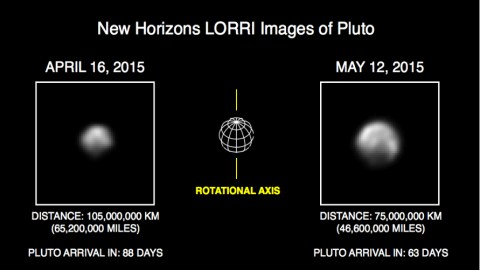New Images of Pluto from New Horizons Gradually Reveal More Detail

If you’re a fan of the TV forensics trope in which Gary Sinise or whoever urges the aloof computer geek to “ENHANCE” a pixelated image, then the continuing saga of NASA’s Pluto re-education is sure to fascinate.
As you probably know, NASA’s New Horizons spacecraft is hurtling through space toward the dwarf planet, sending back illuminating new images of the cryptic sphere. Before its journey, this photo used to be the best shot we had of Pluto and its celestial associates: Charon, Nix, and Hydra. Happily for astronomers and other, less-professional space lovers, New Horizons’ most recent dispatches include photos that have already augmented our understanding of Pluto’s surface geography.



From NASA:
“A technique called image deconvolution sharpens the raw, unprocessed pictures beamed back to Earth. In the April images, New Horizons scientists determined that Pluto has broad surface markings — some bright, some dark — including a bright area at one pole that may be a polar cap. The newer imagery released here shows finer details. Deconvolution can occasionally produce spurious details, so the finest details in these images will need confirmation from images to be made from closer range in coming weeks.”
Not bad for photos taken from 50 million miles (77 million kilometers) away. It’s hard enough for me to snap a decent picture on my cellphone camera without getting a thumb in the way. NASA scientists cite the visual evidence of the ice caps, plus variations of surface details when observed from different angles, to support hypotheses that Pluto’s surface geology is more varied than initially supposed.
Bob King of Universe Today offers a strong assessment of these new images, and clues us in on what to expect moving forward:
“Watch for dramatic improvements in the images as New Horizons speeds toward its target, covering 750,000 miles per day until closest approach on July 14. By late June, they’ll have four times the resolution; during the flyby that will improve to 5,000 times. The spacecraft is currently 2.95 billion miles from Earth. Light, traveling at 186,000 miles per second, requires eight hours and 47 minutes — the length of a typical work day — to make the long round trip.”
A brief postscript: Whenever we post about things like this there’s always a small contingent of folks who bellyache loudly about the pointlessness of sending spacecrafts out millions and millions of miles to send back pixelated images. Below, Bill Nye the Science Guy gives a great explanation for why this all matters:





